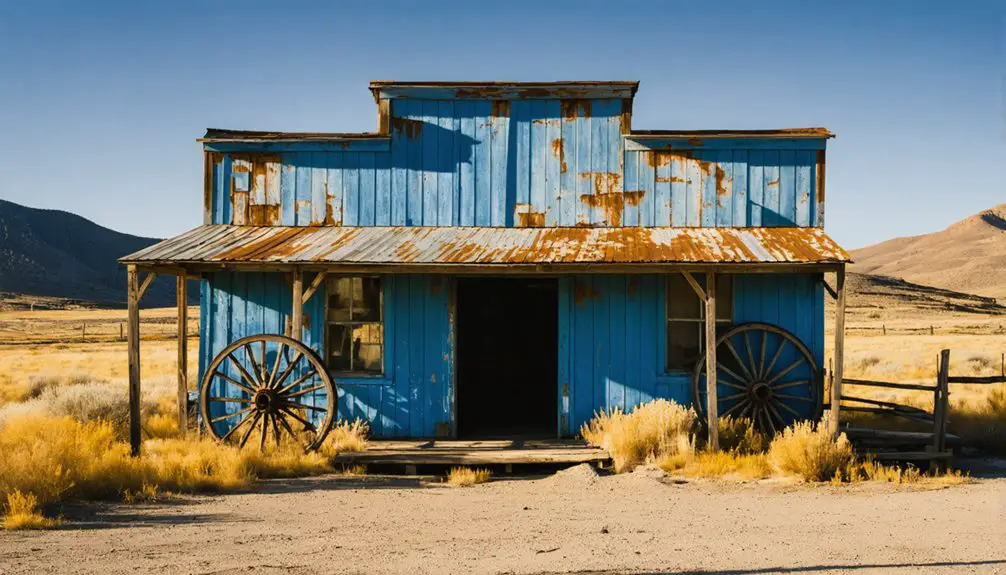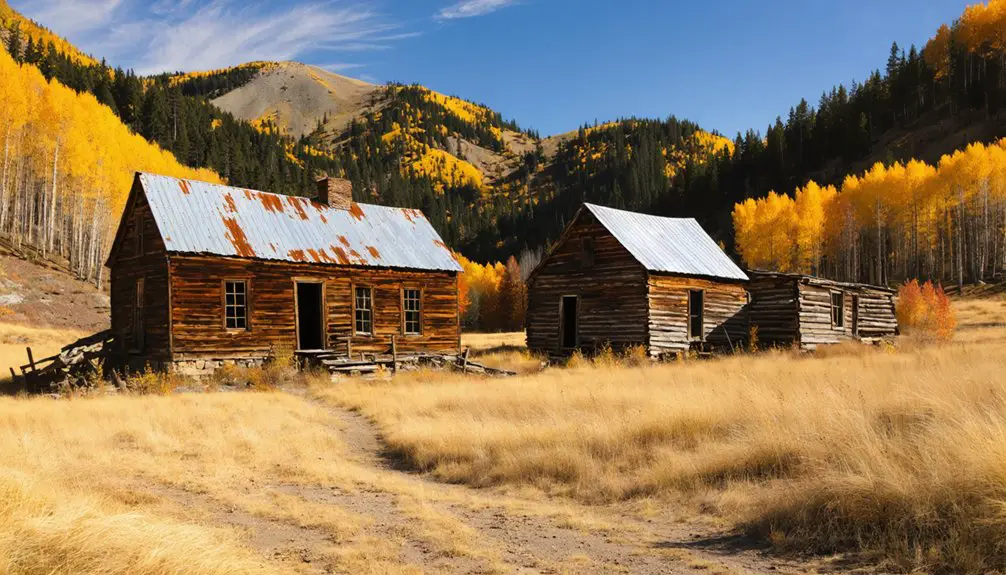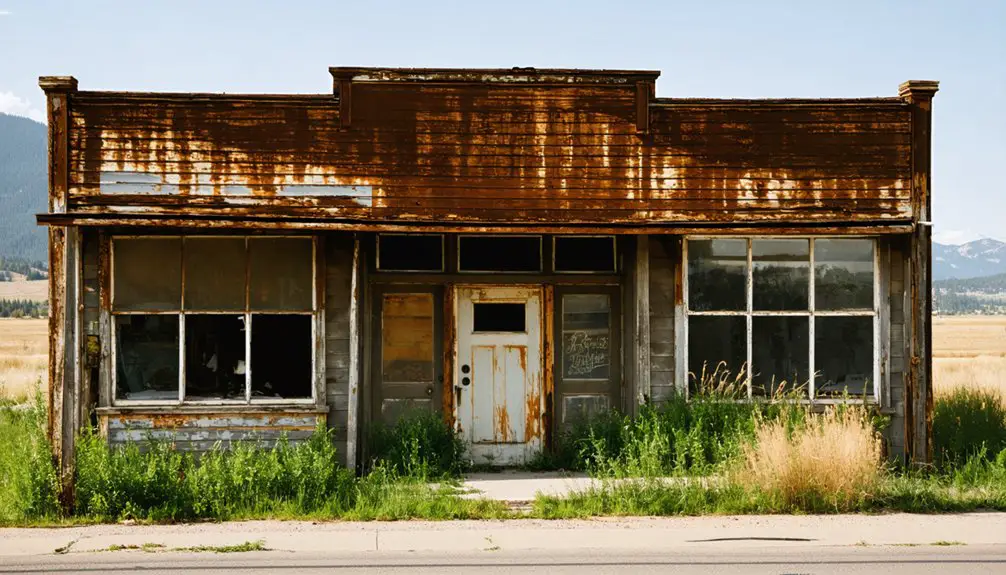You’ll discover Wauconda, Washington, a intriguing ghost town nestled in the Okanogan Highlands that traces its origins to a significant 1898 gold discovery by three prospecting brothers. Today, this remote settlement features abandoned structures including a café, post office, and store, with its most recent sale in June 2024 for $360,000. While the town’s mining operations have long ceased, its historic buildings and mining remnants offer a fascinating glimpse into Washington’s frontier past.
Key Takeaways
- Wauconda became a ghost town after economic challenges in the 1930s led to mine closures and abandonment of core businesses.
- The town’s historical significance includes gold mining operations with a 60-ton stamp mill and over 2,000 feet of tunnels.
- Recent purchase in June 2024 for $360,000 left abandoned café, convenience store, post office, and gas station needing extensive restoration.
- The ghost town features preserved frontier-era structures including the 1928 General Store & Restaurant and 1908 Pflug Mansion.
- Located along WA State Route 20, Wauconda maintains a sparse population density of 1 person per mile with minimal business activity.
A Mining Legacy Born in 1898
When three brothers discovered gold in 1898, they laid the foundation for what would become Wauconda, Washington, a bustling mining settlement in northeastern Okanogan County.
During the height of Washington’s gold rush era, their discovery sparked rapid development as the Wauconda Gold Mining Company established a significant presence in the area. The town’s infrastructure grew to include a 60-ton stamp mill for processing the extracted ore.
You’ll find the early mining techniques focused on extracting high-grade gold from surface and near-surface zones, with some deposits yielding up to 20 ounces per ton.
The company invested heavily in infrastructure, creating over 2,000 feet of crosscuts and mine tunnels. They implemented mercury amalgamation and cyanidation methods to process the valuable ore.
The town quickly grew around these operations, with multiple mining claims staked throughout the district, including three patented and eighteen unpatented mines.
From Boom to Ghost: The Town’s Evolution
Throughout its history, Wauconda underwent two significant relocations that reshaped its physical presence in northeastern Washington. First in 1900 to the Community Hall site, then again in 1936 when State Highway 20’s construction bypassed the original location. About 150-200 yards from the main camp, visitors can still spot the remains of a dilapidated cabin site.
As mining challenges intensified in the 1930s, you’d have witnessed the town’s remarkable transformation. While the Sheridan Mines closed during the economic downturn, agricultural resilience emerged through family-owned operations like the Thomason Ranch. The area became notorious for its exceptional moonshine production during Prohibition.
Despite the shift from mining boom to ghost town status, you’ll still find active elements of community life, including the post office and café. The descendants of original settlers maintain their connection to this historic place, preserving Wauconda’s legacy through ranching and farming activities that continue to this day.
Life in Modern-Day Wauconda
You’ll find minimal business activity in today’s Wauconda, with its once-bustling cafe, post office, and store now standing abandoned.
While a few home-based enterprises like Okan Arts once operated in the area, most have relocated due to logistical challenges and the town’s remote nature. The aging local demographic, with a median age 58, has contributed to the decline in entrepreneurial ventures.
Despite its ghost town status, the scattered residents maintain their frontier lifestyle, adapting to long drives for basic services and preserving their connection to the region’s mining and ranching heritage. The sparse population of only 1 person per mile reflects the area’s extremely isolated character.
Current Business Operations
While Wauconda was recently purchased in June 2024 by Neal and Maddie Love for $360,000, the town’s core businesses remain non-operational. The abandoned café, convenience store, post office, and gas station present significant business challenges for the new owners, as these structures require extensive restoration work. These purple buildings remain a landmark of the town center.
The owners had to face a well replacement among their first challenges after moving in. You’ll find the nearest shopping and services about 35 minutes away in Republic or Tonasket, highlighting the town’s remote nature.
Despite having satellite internet service, the spotty connection could hinder potential business ventures. The lack of community engagement stems from the area’s low population density, with most daily activities requiring travel to neighboring towns.
While the Love’s purchase includes commercial buildings and a four-bedroom house, reviving Wauconda’s business operations will require substantial investment and planning.
Preserving Community Heritage
Despite its diminished population, Wauconda maintains a rich cultural heritage through active preservation efforts and community engagement.
You’ll find descendants of early settlers still living here, upholding community traditions passed down through generations. The historic Community Hall, built in 1914, continues to serve as the heart of local gatherings and celebrations.
Heritage preservation efforts focus on protecting significant landmarks like the Thomason Ranch, which has remained in the same family for over a century. The town was first established when three brothers founded it as a mining settlement in 1898. The area’s rich mining legacy includes the nearby Bodie gold mine, which produced $1.3 million in gold between 1903 and 1940.
You can explore the area’s mining origins through preserved sites like the Sheridan Mines, while local residents share oral histories of the region’s evolution from a mining boom town to a farming community.
The community’s dedication to maintaining these historical connections guarantees Wauconda’s story lives on through both its physical landmarks and living memory.
Exploring Nearby Mining Sites
As you venture into the Wauconda Mining District, the historic Bodie Mine stands as one of the area’s most significant sites, having produced approximately 15,000 tons of high-grade ore between 1902 and 1916.
You’ll find remarkable gold concentrations that once reached up to 20 ounces per ton near the surface, with ore composed of parallel quartz veinlets throughout the property.
The nearby Sheridan Mine offers a glimpse into another fascinating chapter of local mining history, with its colorful mineral-stained walls and preserved timbered ceilings.
You can still spot evidence of historic mining techniques, though the tunnel entrances are now partially sealed.
The site’s silver, gold, and lead deposits attracted various mining operations well into the 1930s, making it a reflection of the region’s rich mineral wealth.
The original settlement was established along Granite Creek, where miners first discovered promising mineral deposits.
Planning Your Visit to Wauconda

You’ll find the best time to explore Wauconda is between May and September when mild weather allows for comfortable outdoor activities and ideal visibility of historic sites.
Getting there safely requires following State Highway 20 east from U.S. Highway 97 at Tonasket, with roads generally suitable for standard vehicles throughout the warmer months.
Be prepared with appropriate gear and navigation tools, as the remote location demands self-sufficiency, especially if you’re planning to combine your visit with trips to nearby ghost towns like Bodie or Sheridan Mines.
Best Seasons To Explore
The best window for exploring Wauconda ghost town spans from May through September, when warm temperatures and clear conditions create ideal circumstances for visitors.
During these months, you’ll find accessible trails and excellent visibility for exploring abandoned mines and historical sites.
For seasonal highlights, spring and fall offer fewer crowds and stunning natural displays – from early blooms to vibrant autumn foliage.
Summer brings the warmest weather, perfect for hiking nearby trails and rock collecting at old mine sites.
Visitor tips: pack layered clothing regardless of season, as mountain weather can change quickly.
You’ll want to avoid winter months when snow often blocks access roads and trails.
The shoulder seasons of late spring and early fall provide a balanced mix of good weather and peaceful exploration opportunities.
Getting There Safely
Planning a safe journey to Wauconda ghost town requires careful preparation due to its remote location in Okanogan County. You’ll find the site along WA State Route 20, with Oroville and Tonasket serving as the nearest service towns, 20-30 miles away.
For ideal road safety, equip your vehicle with a full tank of gas, emergency supplies, and offline navigation tools. You’ll need a high-clearance vehicle or SUV to tackle the unpaved secondary roads, and during winter months, snow chains or winter tires are essential.
Before heading out, inform someone of your travel plans and pack plenty of water, as cell service is unreliable. Vehicle preparation should include a basic emergency kit with spare tire, jack, and first aid supplies to handle any unexpected situations in this rugged terrain.
Historical Landmarks and Architecture
Visitors to Wauconda’s historic district will discover a rich architectural legacy spanning the late 19th and early 20th centuries.
You’ll find remarkable preservation efforts at sites like the 1928 General Store & Restaurant and the distinguished Pflug Mansion from 1908. The architectural significance of these structures showcases typical Western frontier design, including wooden false-front facades and simple gabled roofs.
In nearby Bodie Ghost Town, you’ll encounter authentic mining-era buildings straddling Toroda Creek Road.
While a 1962 fire claimed much of the mill infrastructure, surviving structures include mine offices, residential cabins, and commercial buildings that paint a vivid picture of frontier life.
The site’s gold mills, equipment foundations, and ore processing remains serve as evidence to the area’s $1.2 million mining heritage.
The Natural Beauty of Wauconda Pass

Nestled at an elevation of 4,310 feet, Wauconda Pass stands as a pristine gateway to the rugged Okanogan Highlands, where alpine meadows blend seamlessly with dense coniferous forests.
You’ll discover a remote wilderness that transforms dramatically with each passing season, offering exceptional opportunities for wildlife observation and seasonal hikes.
Whether you’re seeking solitude or adventure, the pass delivers with:
- Panoramic vistas stretching across valleys and distant mountain ranges
- Pristine winter snowfall perfect for skiing and snowshoeing
- Diverse flora and fauna, including specialized alpine species and abundant birdlife
You’ll find yourself immersed in a carefully preserved natural sanctuary where conservation efforts guarantee this slice of Pacific Northwest wilderness remains untouched for future generations to explore.
Frequently Asked Questions
Are There Any Paranormal Activities Reported in the Abandoned Buildings?
You won’t find any documented ghost sightings or haunted locations in these abandoned buildings. Unlike other ghost towns, there’s no evidence of paranormal activity in any historical records or investigations.
What Happened to the Original Wauconda Mines’ Equipment and Machinery?
Like downloading old files, the mining equipment was mostly cleared out by 1934, except for a steam boiler. Northern Gold later installed new crushing machinery and Wilfley tables for enhanced processing.
Did Any Famous Outlaws or Notable Historical Figures Visit Wauconda?
You won’t find records of any famous visitors or notorious criminals in Wauconda’s history. The town’s documented past focuses on local miners, ranchers, and pioneer families rather than outlaws.
Were There Any Major Disasters or Accidents During the Mining Era?
While there’s evidence of mining accidents throughout Washington’s mining regions, you won’t find specific documented disasters in Wauconda’s mines, though they likely faced similar hazards as neighboring operations.
What Native American Tribes Originally Inhabited the Wauconda Area?
Since time immemorial, you’ll find the Cultural heritage of Coast Salish Native tribes shaped this majestic landscape. The Okanogan and Colville peoples were the original inhabitants of this mountainous territory.
References
- https://www.ghosttowns.com/states/wa/wauconda.html
- https://www.trailchick.com/bodie-ghost-town/
- https://www.instagram.com/p/DKuyZrpsJtA/
- https://www.youtube.com/watch?v=wV7U5UbMKLg
- https://en.wikipedia.org/wiki/Wauconda
- https://www.instagram.com/p/DK1UyyHupwQ/
- https://www.hmdb.org/m.asp?m=274064
- https://www.dnr.wa.gov/Publications/ger_ic106_iaml_bodie.pdf
- https://www.dnr.wa.gov/publications/ger_b73_myerscreek_wauconda_mine_dist.pdf
- https://www.waucondahistory.org/wp-content/uploads/2021/07/wths-timeline-updated.pdf



